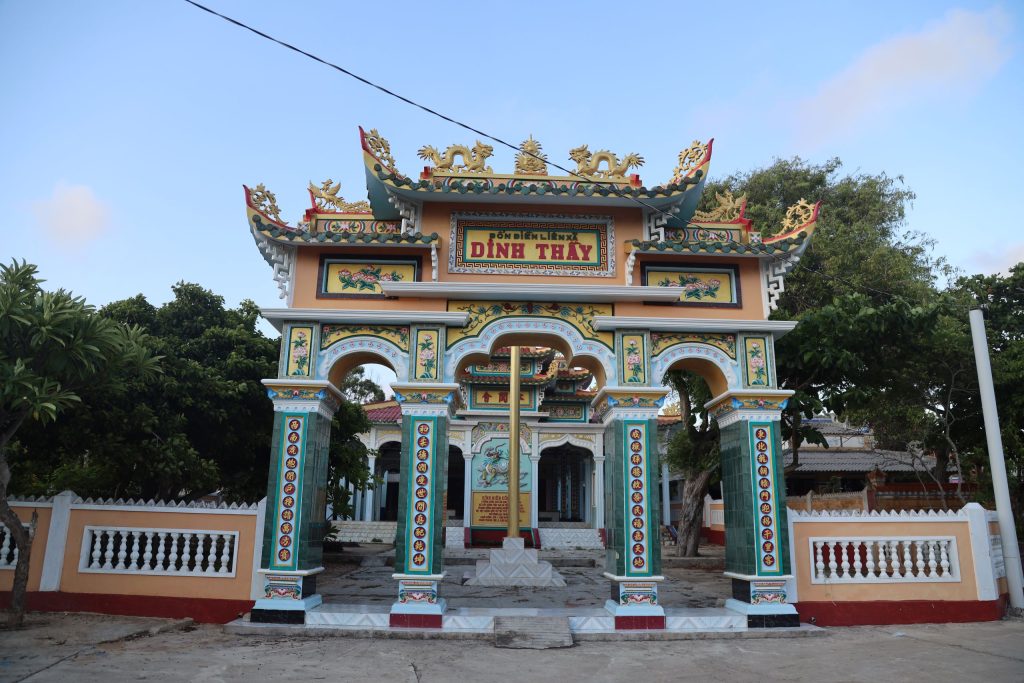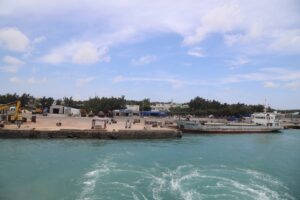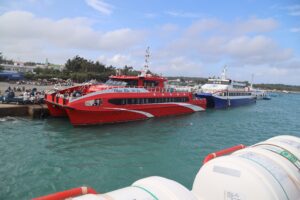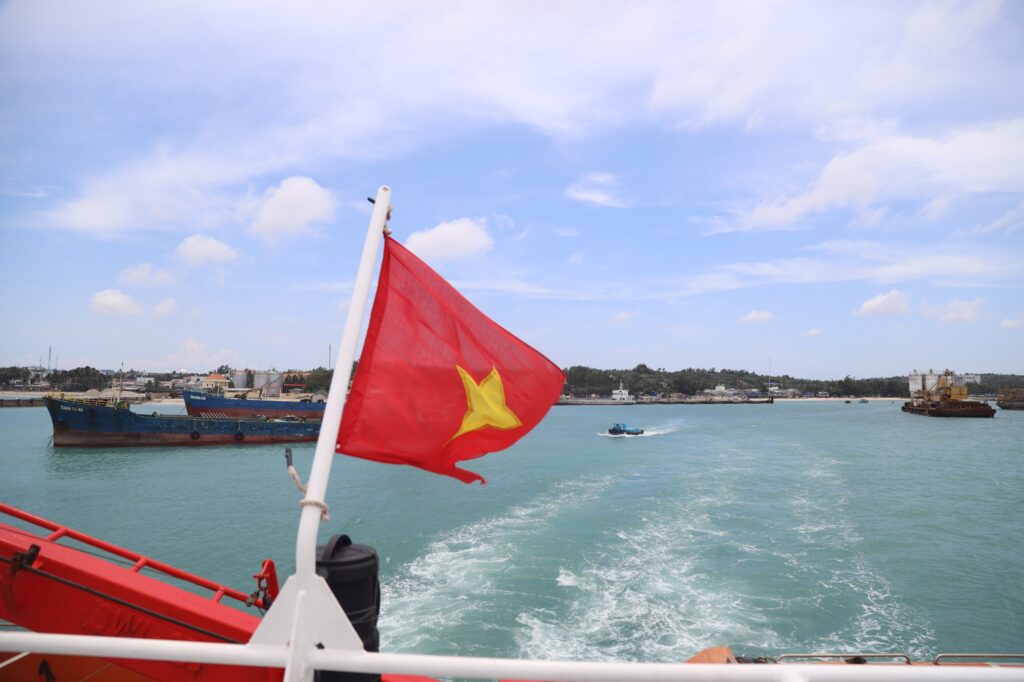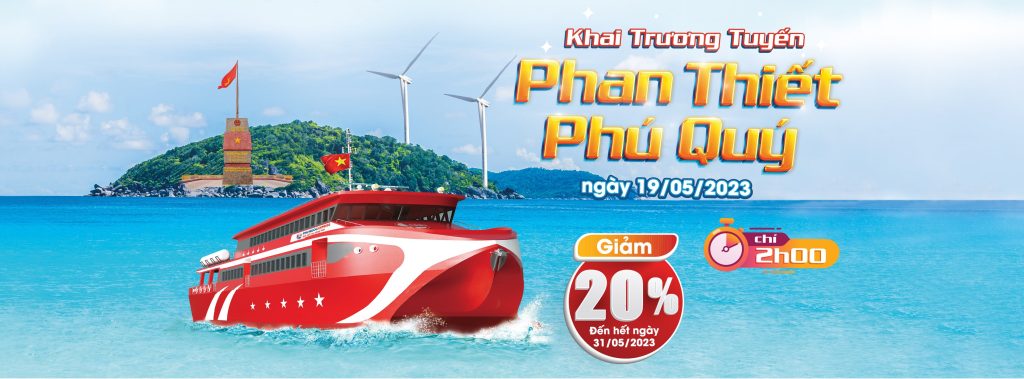To facilitate worship without having to travel far, the Vietnamese people on the island built the Temple of Thầy Sài Nại (known as Dinh Thầy) in the 16th century at Ngũ Phụng, on a high hill northeast of An Hòa village.
Architecture of Dinh Thầy Nại
The architectural complex of Thầy Sài Nại’s temple includes the main gate, flagpole, windscreen wall, Võ ca (ceremonial hall), and the main sanctuary. The temple faces southwest. The main gate, Võ ca, and main sanctuary have architectural features similar to traditional village communal houses and shrines: a three-entrance gate, a square-shaped building with four sloping roofs, and decorative reliefs of dragons, phoenixes, flowers, and foliage on the roof ridge.
Inside the main sanctuary, there are three altars: the central altar dedicated to Thầy Sài Nại, made of assembled wood with vivid lacquer and gold leaf, with the Chinese character “Thần” (Deity) in the center; the left altar honors the Tiền Hiền (Forefathers), and the right altar honors the Hậu Hiền (Later Immigrants), both constructed similarly. The altar canopies are intricately carved with motifs of two dragons chasing a pearl, birds, animals, plum blossoms, orchids, chrysanthemums, bamboo, vines, and classical Sino-Vietnamese calligraphy couplets.
The Nguyễn dynasty kings granted eight imperial decrees (sắc phong) to Thầy Sài Nại, which are carefully preserved in rotation by the nine villages across three communes in Phú Quý district. Every year on the 4th day of the 4th lunar month, villagers from all over the island organize a procession to ceremonially bring the sắc phong from its storage to the temple for worship. This festival is conducted with many solemn rituals passed down through generations.
The Legend of Building Dinh Thầy
One morning, a group of children playing hide-and-seek at Bàu Bưng suddenly witnessed a boy possessed by a spirit claiming to be Thầy Nại. This surprised the children, who were skeptical and brought the boy back to the village for the elders to question him. Upon arriving at the village entrance, the boy said he was Thầy Nại and that his tomb was located on a promontory extending into the sea (now the site of Thầy’s grave in Long Hải commune). He wished to use the spirit medium to tell the villagers: “If you agree to build a temple for me, I will protect the village so its people remain strong and safe, and bless the country with peace.”
The villagers were delighted and urgently asked him to indicate where to build the temple. The boy then led them to the chosen spot (the current location of Thầy Nại’s temple). However, a large duối tree, with a trunk so wide it took four people to embrace it, stood at the center of the site, called the “heart of the temple” (tim dinh), and needed to be removed. Young men from the 12 villages (before they were merged) were mobilized to clear the area, but the tree trunk could not be uprooted, causing distress.
Suddenly, another boy possessed by the spirit of Thầy Nại appeared, requesting the villagers prepare offerings (porridge, sugarcane, incense, candles, etc.) to “invite the hidden soldiers.” After the offerings were made, the boy stood up, embraced the tree trunk, uprooted it, and carried it away. A place of worship was then erected with bamboo and earth walls. After several restorations, Dinh Thầy Nại became as spacious and solemn as it is today.
Because of its outstanding tangible and intangible cultural values, on September 7, 2010, the People’s Committee of Bình Thuận province officially recognized the Temple of Thầy Sài Nại as a provincial-level historical and cultural site under Decision No. 1993/QĐ-UBND.
The Miraculous Power of Thầy Nại in Phú Quý
Thầy Nại is a highly revered deity. Locals remind one another that in times of hardship, simply reciting his holy name and prayers like:
“Thầy Sài Nại Thông linh Chiêu ứng Mặc chất Đoan túc gia tặng Dực bảo Trung hưng Tiết kinh Quang ý Trung đẳng thần phù hộ…”
will bring success and smooth outcomes.
Fishermen often recount that when boats get stuck on underwater reefs and cannot be freed by others, families bring offerings to Thầy’s tomb, pray, and then the boats are safely freed.
The Nguyễn dynasty kings bestowed eight imperial decrees on Thầy Sài Nại, which are carefully preserved by the nine villages in rotation. Every year on the 4th day of the 4th lunar month, islanders organize a procession to ceremoniously carry the sắc phong from storage to the temple for worship. The festival includes many solemn and continuous rituals, according to long-standing island customs.
The Temple of Thầy Sài Nại carries profound cultural and historical significance, clearly reflecting the cultural exchange and integration between the Vietnamese and Chinese communities over centuries of coexistence on this remote island. It also exemplifies the rich folk cultural life of the Phú Quý community. Having existed for more than 300 years, cared for and maintained by successive generations from the Cham people to the Vietnamese villagers, the temple continues to preserve and uphold traditional worship practices. Due to its preserved tangible and intangible cultural values, it was officially recognized by Bình Thuận province as a Provincial Historical and Cultural Relic on September 7, 2010, Decision No. 1993/QĐ-UBND.



